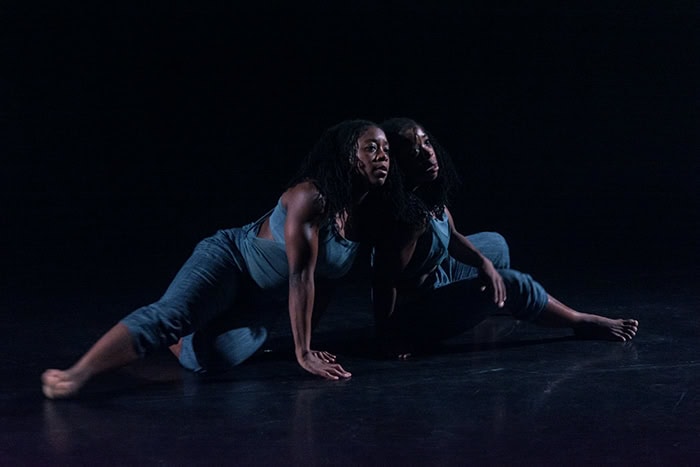Alleyne Dance, Far From Home, Dance East
Posted: June 7th, 2023 | Author: Nicholas Minns | Filed under: Performance | Tags: Alleyne Dance, Bertolt Brecht, Emanuele Salamanca, Giulia Scrimieri, Kristina Alleyne, Sadé Alleyne, Salvatore Scollo | Comments Off on Alleyne Dance, Far From Home, Dance EastAlleyne Dance, Far From Home, Dance East, Ipswich, April 21

Alleyne Dance’s Far From Home, presented at Dance East in April, treats the question of immigration and assimilation with a warmth and empathy that is crucially missing from current political discourse. The work speaks on behalf of migrants by using their own voices not only to make them heard above the clamour of public opinion but to extrapolate a humanitarian resolution to their situation. Immigration, of course, has underpinned the UK’s cultural life since before the Romans landed, and the issue of who can reside in this country and under what conditions has exercised social and political discourse ever since. Only recently, unscrupulous politicians used the fear of a migrant ‘invasion’ to make the case for ‘taking back control’ of our borders in the run-up to the Brexit referendum.
Alleyne Dance — the twin sisters, Sadé and Kristina Alleyne — has developed a powerful choreographic presence through work based on the image of their twin selves: small scale embracing significant themes. In Far From Home, a co-commission by The Place London, Dance City Newcastle, Dance East and Dampfzentrale Bern, the Alleyne sisters again take on a significant theme but increase the scale of the work by employing a cast of six professional dancers — including themselves — and a multi-generational group of non-professionals recruited from the local community. Such a shift in scale may be a necessary step in the evolution of Alleyne Dance, but it comes with challenges. In their previous work as a duo, the physical and mental bond between Sadé and Kristina has been a syntax that is both compact and expressive; they can play off each other with the confidence of a unified language. With an enlarged cast, that strength of common language is dispersed and weakens the choreographic treatment. At the same time the excellent production values — Emanuele Salamanca’s set, Giulia Scrimieri’s costumes, Salvatore Scollo’s lighting and Nicki Wells’ music — seem to conspire towards a rounded entertainment that, instead of highlighting the gravity of the subject, effectively masks it. The German playwright Bertolt Brecht experimented with this balance in the performance of his plays so as to free a critical approach to the story from the illusory effects of theatrical convention. The polemics of immigration in Far From Home are implicit in the voices it presents, but the voices merge too much into the production values for the polemics to register. One need look no further than their previous work, A Night’s Game, to see how the Alleyne sisters can find exactly the right balance when they put the subject of incarceration into powerful emotional focus.
It may be an unintended consequence of the commission of Far From Home that has compromised the Alleyne sisters’ critical approach to their subject. The decision to use local, non-professional movers in a production is a way for theatres to strengthen ties with their community but from the perspective of the production, the disparity in movement styles can compromise choreographic invention. Allocating the role of migrants to the professional dancers and those of a host community to the local cast only exacerbates this divide. On the other hand, transferring the Alleyne sisters’ own muscular choreography to the professional dancers can end up in gratuitous acrobatics, drawing attention to itself for the wrong reasons.
Where the Alleyne sisters reveal their sense of history most powerfully are in the images throughout the production that show, sometimes overtly and sometimes subliminally, the intimate relationship between immigration and slavery: the opening setting of long braids on the floor like the points of a compass, the pulling of ropes against an unseen force, and, for a fleeting moment on a crowded stage, the awful sense of bodies adrift in the water, reminiscent of JMW Turner’s painting Slave Ship (Slavers Throwing Overboard the Dead and Dying, Typhoon Coming On). Not all images work, however: At the end of Far From Home, updating history to the present, we are left to contemplate a pile of bodies washed up under a high shower head of dripping water. You know its significance, but it misses its mark by reducing the human loss and the absence of empathy that caused it to an image that is less disturbing than all too theatrically literal.
Far From Home is a stage of development for Alleyne Dance in response to an important commission, but it reveals some of the pitfalls in scaling up production. What is not in doubt is the hard-hitting intent at the core of their work.
(Alleyne Dance has just been announced as the winner of the Best Independent Company Award at the 2023 National Dance Awards in London.)
